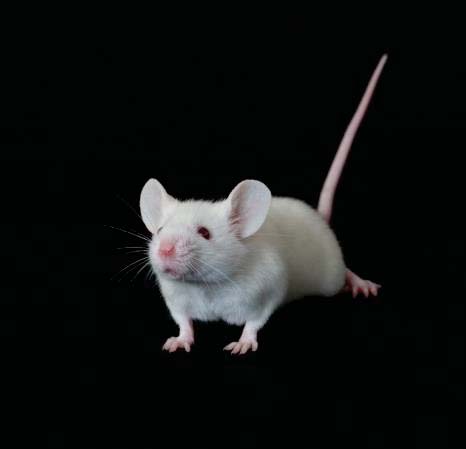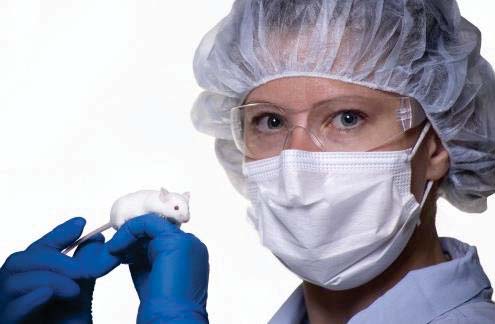Slide



Tips and Tricks for
the Care of NSG
Mice
Dominique Kagele, Ph.D.
Technical Information Services


The Jackson Laboratory's Mission
Performing Research
Investigating genetics and biology of human disease
Providing Resources
JAX® Mice Clinical & Research Services, bioinformatics data,
technical publications and more…
Educating Scientists
World-class courses, internships and other programs
www.jax.org/courses


JAX® Mice
JAX® Mice
The Gold Standard for Biomedical Research
The Gold Standard for Biomedical Research
NIH funded resource
>7,500 strains and growing
Unsurpassed genetic quality & animal health
Best characterized & referenced 100 new pubs/week
Common inbred strains (C57BL/6J, BALB/cJ, DBA/2J) support development/collection of specialty strains and other valuable community research resources

Online Resources to Expedite
Research
JAX® Mice Database
www.jax.org/jaxmice
Mouse Genome Informatics www.informatics.jax.org
Mouse Phenome Database www.jax.org/phenome
And many more unique resources
Presentation Overview
Handling and
Care of the
NSG Mouse
JAX® Mice
Presentation Overview
Learning Goals
Explain features and uses of NSG mice
Identify the types and signs of common infections in NSG mice
Describe the processes and caging recommendations for successful care of NSG mice
JAX® Mice
Presentation Overview
Learning Goals
Explain features and uses of NSG mice
Identify the types and signs of common infections in NSG mice
Describe the processes and caging recommendations for successful care of NSG mice
JAX® Mice
Immune System Components
JAX® Mice
A Spectrum of Immune Deficiency
Immune deficient
Immune competent
JAX® Mice
Severely Immune Deficient Strains
䇾Fragile Superheroes䇿
Rag1/Rag2
NOD scid gamma (NSG)
JAX® Mice
Immune System Components
JAX® Mice
Immune System Components
JAX® Mice
Immune System Components
JAX® Mice
Immune System Components
JAX® Mice
Immune System Components
JAX® Mice
NSG, NOD scid gamma:
Features
Official nomenclature: NOD.Cg-Prkdcscid Il2rgtm1Wjl/SzJ (005557)
Many Immunological Deficiencies
NOD background contributes innate immune deficiencies
o Macrophages, dendritic cells defective
o No complement system
o Bone marrow readily colonized by human hematopoietic stem cells
scid mutation prevents development of mature T and B cells
Il2rg gene knockout blocks signaling from 6 distinct interleukins and blocks NK cell
development
Benefits:
No scid leakiness
Longer lifespan than NOD scid (mean lifespan 22 months)
Highly resistant to thymic lymphoma development,
To find NSG information online, visit
as compared to other scid mutant strains
JAX® Mice
NSG Research Applications
An incredibly useful and versatile immunodeficient
mouse model
Research applications:
Primary tumor engraftment
Human hematopoiesis
Infectious disease
Regenerative medicine
To find NSG information online, visit
JAX® Mice
Presentation Overview
Learning Goals
Explain features and uses of NSG mice
Identify the types and signs of common infections in NSG mice
Describe the processes and caging recommendations for successful care of NSG mice
JAX® Mice
NSG mice
Infectious Disease Concerns
High level of immunodeficiency results in extreme
susceptibility to:
Pathogenic microorganisms:
o Infectious agents that typically causes disease in
immunocompetent hosts
Opportunistic microorganisms:
o Potentially infectious agents that rarely cause disease in
immunocompetent hosts
Commensal microorganisms:
o Potentially infectious agents that reside in normal host tissues
without causing disease
Foreman O, et al. 2011. Vet Pathol. [PMID: 20817888]
JAX® Mice
Pathogenic and Commensal Microbes
Common Threats to NSG mice
Citrobacter
Enterobacter
Enterococcus spp.
Klebsiella spp.
Pneumocystis murina
Pseudomonas
S. aureus
Coagulase-negative Staphylococcus spp.
JAX® Mice
Infectious Disease Concerns
Opportunistic Infections
Opportunistic microorganisms normally present
in gut flora of healthy mice can become
pathogenic in NSG mice, most commonly:
o Klebsiella oxytoca o Enterococcus spp.
o Hunched posture, scruffy coat o Females (twice as likely to be infected)
Foreman O, et al. 2011. Vet Pathol. [PMID: 20817888]
JAX® Mice
Contributing Factors to Mortality
Opportunistic Infections
Urinary tract infections (UTIs)
o Normal intestinal flora o Estrogen supplementation (increased risk)
Ascending renal infection and pathology
Secondary infection after primary insult
o Skin wounds (ie needle punctures, bacterial dermatitis) o Molar gingival sulcus
Breeding (often lactating) females more susceptible
JAX® Mice
Signs of Infection
Commonly Observed in NSG mice
Infected skin wounds, cellulitis
Abscesses (skin and internal organs)
Otitis media, conjunctivitis, panophthalmitis
Localized and widespread infections involving liver, heart, lungs, uterus, accessory sex glands, etc.
Forman et al. 2011.Vet Pathol. 48(2):495-9. PMID:20817888
JAX® Mice
Infections in NSG mice
Contributing Factors
Can occur in mice housed under less strict barrier conditions, strict barrier conditions, and isolators
Most often seen after mice have been in the facility a while
Often appear to be an individual animal vs. colony issue
o Sporadic o Sick and healthy (or infected/non-infected) animals commonly
in the same cage
JAX® Mice
Presentation Overview
Learning Goals
Explain features and uses of NSG mice
Identify the types and signs of common infections in NSG mice
Describe husbandry and caging recommendations for successful care of NSG mice
JAX® Mice
How Clean is Clean Enough?
Decontamination
inactivation of all
inanimate surfaces
JAX® Mice
How Clean is Clean Enough?
Housing Conditions
Barrier practices adequate to maintain nude, or even scid mice may not be adequate for NSG
o Sanitize hands before gloving (washing) o Disinfect surfaces (laminar flow hoods, experimental equipment,
o Sterilize tools (forceps, scissors, ear punches, etc), bedding, and
o More frequently change cages o Monitor for pathogens frequently (swabbing)
JAX® Mice
Care and Handling of NSG mice:
Personal Protective Equipment
Personal Protective Equipment (PPE)
o Sterile scrubs, gloves, dedicated
shoes and shoe covers
o Mask, goggles, hair/beard bonnet o Sterile smock o PAPR (Powered air purifying
respirator): if necessary
Environmental Conditions:
Suggestions
Entry room/space (anteroom or dedicated hallway) o Clearly marked with tape and/or signageo Limited entryo Air shower (if available)
JAX® Mice
Environmental Conditions
Sterilize or disinfect anything that may come into contact with the mice (autoclave or vaporized hydrogen peroxide (VHP))
Use laminar flow hoods (or biosafety cabinet working with human pathogens) whenever possible
Micro-isolator/ individually ventilated cages (IVCs) o HEPA (High-efficiency particulate absorption) filtered
Cage Changes: o More frequent o Perform in disinfected laminar flow hood o Disinfect gloved hands and anything goes into the hood o Disinfect forceps (Wescodyne) between cages o If hands leave hood, disinfect again
JAX® Mice
NSG Mice at JAX:
Barrier Conditions
Maximum barrier at JAX:
Sterilized individually ventilated caging
Sterilized feed and drinking water
Air shower entry
Change into clean room processed scrubs, smock and shoes
Gloves, air hat or mask, cap and face shield
Under maximum barrier conditions at JAX, bacterial disease in NSG are uncommon – less than 1% of mice >200 days
Overview of barrier levels at JAX: http://jaxmice.jax.org/health/barrier.html
Experimental Procedures and
Transport
Disinfect experimental equipment and environment (especially shared)
Sterilize smaller tools (by autoclaving)
MAP test and/or culture material prior to implantation to ensure sterility
Use secondary containment during transportation
o Plastic bag o Sterile smock
Breeding NSG mice
NOD.Cg-Prkdcscid Il2rgtm1Wjl/SzJ (005557)
Homozygote/homozygote female x homozygote/hemizygote male
No need to genotype pups, but genotype breeders
Rotate every 8-9 months
Replace if no litters in 60 days or if appear sick
NSG Mice
Care and Husbandry Suggestions
Food o Autoclaved and/or irradiated
Water o Acidified to pH 2.5 - 3.0 with HCl (or chlorinated) to control
for Pseudomonas spp.
o Autoclaved
o No antibiotics added routinely
Pathogens monitored o Directly (infected mice) o Indirectly (sentinel mice)
JAX® Mice
Pathogen monitoring
Sentinel mice are those used for the detection of pathogens present in the room, and include:
o Dirty-bedding (mostly fecal-oral) o Cage-contact (direct contact,
aerosol, urine, fecal-oral)
o Exhaust air (aerosolized)
Use both immunocompetent and immunodeficient (including NSG periodically) as sentinels
For more information, please visit http://jaxmice.jax.org/jaxnotes/archive/497j.html
Health Monitoring Considerations
Expanded health surveillance to detect all organisms excluded from barrier, including opportunistic bacteria
o Shedding often intermittent
o ↑ Non-lethal monitoring, e.g., fecal or oropharyngeal swab
culture of colony mice desirable
Immune competent mice may be transient carriers of opportunists that cause significant disease in immune deficient (e.g., Corynebacterium, Pneumocystis)
o Testing may fail to detect due transient nature o Test immunodeficient mice directly Direct tests (e,g., culture, PCR), not serology, for severely immune deficient
JAX® Mice
Immunodeficient Mice at JAX:
Animal Health Reports
Health Status Reports: http://jaxmice.jax.org/health/index.html
NSG Mice
Treatment of infection
Antibiotic treatment of individual mice: o Baytril (enrofloxacin)
5-20 mg/kg SC as directed by your verterinarian
o Others (amoxicillin, cephalexin) o No evidence of effectiveness as prophylatic treatment
Pneumocystis containment o Sulfa-Trimethoprim: incorporate in feed or water
50 mg/kg/day trimethoprim + 250 mg/kg/day sulfamethoxazole
o Significant decrease in mortality
Fungi may or may not be detectable by histopath, but continue to be detectable by PCR
Rederivation to eliminate opportunists from colony
Slate AR., et al., JAALAS. 2014.
Marcotte H., et al., J Infect Dis. 1996
JAX® Mice
Humanization
Health Considerations
Possible human pathogens require ABSL2 housing & BSL2 laboratory
Possible mouse pathogens from human donor, e.g., LCMV
o Test tissues (MAP test, and/or culture bio-materials)
Graft vs. host disease – severely immune deficient mice 䇾attacked䇿 by human tissue / cell transplants
o Hunched posture, ruffled fur, reduced mobility, tachypnea,
diarrhea, weight loss and/or hair loss / skin lesions
o Time course (days to weeks) depends on strain of mouse,
irradiation preconditioning, and type(s) and numbers of human cells injected
JAX® Mice
Warning Signs
Non-specific clinical problems
Unthriftiness, diarrhea, wasting, sickliness
Weakness, lethargy
Acute and/or premature death
Breeding problems, including: o Embryonic death o Small litters o Small, weak, and/or sickly pups o Pup mortality
Work With Your Veterinarian!
When breeding performance suddenly declines
Mice appear unhealthy (ruffled fur, hunched, reduced mobility/activity)
Spontaneous death
Positive culture/sentinel mice results
Summary
A little prevention goes a long way!
Handling and
Care of the
NSG Mouse
JAX® Mice
Thank you!
In need of mouse breeding and colony
management expertise to advance your research?
Contact your regional representative today
Contact technical support
JAX® Mice, Clinical & Research Services
1-800-422-6423 • 1-207-288-5845
[email protected] • www.jax.org/jaxmice
Source: http://www.research.uci.edu/facilities-services/ular/ular-documents/jax_2015_tips_and_tricks_nsg_mice.pdf
fisio-osteo.it
THE CHARTERED SOCIETY OF PHYSIOTHERAPY A clinical for the use of injection therapy by This clinical guideline was endorsed by the Chartered Society of Physiotherapy in January 1999. The endorsement process has included review by relevant external experts as well as peer review. The rigour of the appraisal process can assure users of the guideline that the recommendations for
Microsoft word - beneficial effects of raw milk vuitton.doc
Risk versus benefit of raw milk consumption Dominique Angèle VUITTON WHO Collaborating Centre; University of Franche-Comté; 25030 Besançon, France Background: the contradiction between "food safety" and biodiversity, high quality of products, sustainable development, and healthy life style. Dairy farmers and cheese producers are in the continuing process of answering the somewhat contradictory requirements of consumers for safe, high quality and diversified foods produced in sustainable conditions… at the lowest price. It has turned out that the legitimate requirements of safety from the consumer have eventually evolved in a burden of threats upon producers' activities, once they began being translated in tentative safety regulations. Within the past 10 years, the main concern of numerous producers, with little link with big dairy industry companies, has always been to provide food diversity through a traditional way of producing milk and cheese and to maintain biodiversity while reaching at the same time the very high quality and safety standards requested by the consumers. However, they now have the feeling that their way of doing is not supported in reality by the public policies and that the attitudes of experts and/or authorities may be sometimes quite contradictory.